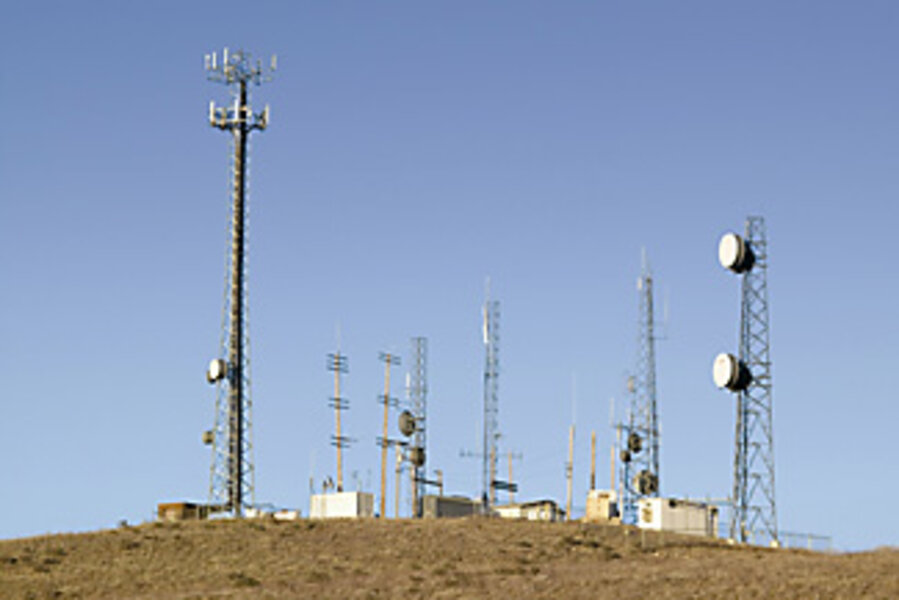A new push to avert cell-tower bird strikes
Loading...
On a pitch-dark night thick with clouds in September 2005, it began raining birds under an 1,100-foot television tower in Madison, Wis.
At the base of the tower the next day, researchers identified 400 birds across 23 species, including five types of golden-winged warblers – a migratory songbird listed as a declining species of "particular concern."
Chalk up one more sad case of a flock of birds striking a communications tower, a problem since such towers began popping up after World War II. (At least 14,000 birds were killed at another Wisconsin tower in 1965.) Yet hopes of solving the bird-strikes-tower problem are soaring.
"This has been an issue for 50 years," says Joelle Gehring, a biologist with the Michigan Natural Features Inventory in Lansing. "But in the past year and a half, for the first time, we have industry and conservation groups coming together to resolve it."
Migrating birds were already under big pressure from loss of habitat and collisions with vehicles, buildings, and power lines. House cats kill huge numbers. At least 4 million and as many as 50 million birds are killed annually in tower collisions, the US Fish and Wildlife Service estimates.
Communication towers are one of the fastest-growing parts of the problem due to the US passion for cellphones and high-definition television. Among about 96,000 towers listed in a federal database, some 22,000 new towers were listed as having gone up in just the past five years.
Last month the US Court of Appeals for the District of Columbia Circuit ordered the Federal Communications Commission to provide more citizen input and comply with US environmental laws including the National Environmental Policy Act when approving new towers.
Yet the problem – and one partial solution for bird strikes – is less about the number of towers and more about the way they are illuminated at night, researchers say. All communications towers 200-feet or higher – and all towers near a flight path or airport – must be lighted according to Federal Aviation Administration (FAA) standards in order to warn pilots away, FCC rules mandate.
Such tower lighting is not a problem for birds in clear weather. But on stormy and foggy nights, when clouds are thickest, migrating flocks of birds tend to zero in on tower lights like moths to a flame.
So what is it about tower lights that attracts birds and keeps them circling until they hit either the tower, support wires, each other, or drop exhausted to the ground? That's what Ms. Gehring set out to find out with her three-year study, which involved switching the types of light bulbs on more than a dozen towers, then tabulating the numbers of dead birds below them.
Today FAA regulations require both steady red lights and flashing red or flashing white ones. What Gehring found: Solid steady red lights were a big problem – creating an aura during cloudy weather that drew in birds.
When solid reds were removed, bird deaths fell 71 percent, according to Gehring's study, which has been peer-reviewed and accepted for publication later this year by the Journal of Ecological Applications.
Gehring's lighting discovery is "a major breakthrough," says Albert Manville, a senior wildlife biologist with US Fish and Wildlife Service in Arlington, Va. But that's hardly the end of the matter, he and others say.
The critical question now becomes: Would turning off the solid red lamps on communications towers, and switching to flashing lights only, mean that pilots would be less able to see them?
If that turns out to be the case, Dr. Manville concedes, those lamps will surely stay on and birds will remain at risk.
"With demand growing so rapidly for more cellphone communications and more emergency broadcasting, and homeland security seeing explosive growth, we know that the growth is going to proceed," Manville says. "The question becomes: How can we put these up in the most bird-friendly way?"
That's what the FAA and FCC now seem set to find out. A spokesman for the FAA says the agency is currently pursuing a new round of testing to determine whether alternate lighting for towers would still be effective in alerting pilots. The FCC, under pressure from the recent appeals-court ruling, is proposing the possibility of altering its lighting scheme for towers and is soliciting public comment.
All of which comes as good news to bird lovers like Darin Schroeder, who directs government relations for the American Bird Conservancy, the Washington-based group whose lawsuit triggered the recent ruling. His group is now partnering with the tower-construction industry and with researchers to examine alternate lighting.
Spokesmen for the Personal Communication Industry Association, the wireless infrastructure association as well as CTIA – the international association for the wireless telecommunications industry – did not return phone calls seeking comment on steps now under way for a tentative working-group agreement on alternate lighting for their towers.
"We know there's a need for emergency broadcasting and we certainly don't want to jeopardize human life," Mr. Schroeder says. "We're not asking anybody to take down their towers or not build them. We think we can work with industry to save millions of birds from dying unnecessarily and still have a great communications system."





